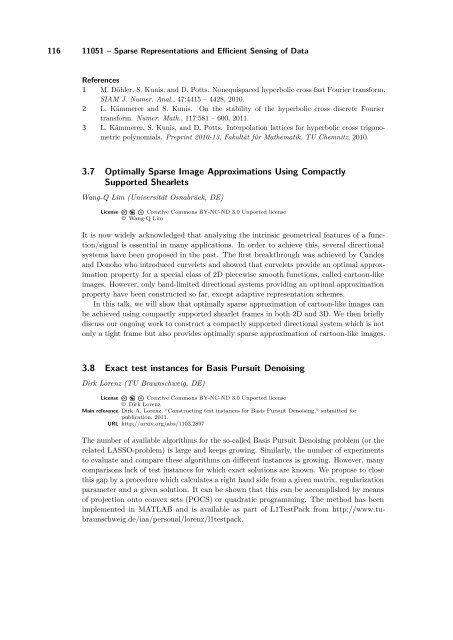Volume 1, Issue 1, January 2011 - DROPS - Schloss Dagstuhl
Volume 1, Issue 1, January 2011 - DROPS - Schloss Dagstuhl
Volume 1, Issue 1, January 2011 - DROPS - Schloss Dagstuhl
You also want an ePaper? Increase the reach of your titles
YUMPU automatically turns print PDFs into web optimized ePapers that Google loves.
116 11051 – Sparse Representations and Efficient Sensing of Data<br />
References<br />
1 M. Döhler, S. Kunis, and D. Potts. Nonequispaced hyperbolic cross fast Fourier transform.<br />
SIAM J. Numer. Anal., 47:4415 – 4428, 2010.<br />
2 L. Kämmerer and S. Kunis. On the stability of the hyperbolic cross discrete Fourier<br />
transform. Numer. Math., 117:581 – 600, <strong>2011</strong>.<br />
3 L. Kämmerer, S. Kunis, and D. Potts. Interpolation lattices for hyperbolic cross trigonometric<br />
polynomials. Preprint 2010-13, Fakultät für Mathematik, TU Chemnitz, 2010.<br />
3.7 Optimally Sparse Image Approximations Using Compactly<br />
Supported Shearlets<br />
Wang-Q Lim (Universität Osnabrück, DE)<br />
License Creative Commons BY-NC-ND 3.0 Unported license<br />
© Wang-Q Lim<br />
It is now widely acknowledged that analyzing the intrinsic geometrical features of a function/signal<br />
is essential in many applications. In order to achieve this, several directional<br />
systems have been proposed in the past. The first breakthrough was achieved by Candes<br />
and Donoho who introduced curvelets and showed that curvelets provide an optimal approximation<br />
property for a special class of 2D piecewise smooth functions, called cartoon-like<br />
images. However, only band-limited directional systems providing an optimal approximation<br />
property have been constructed so far, except adaptive representation schemes.<br />
In this talk, we will show that optimally sparse approximation of cartoon-like images can<br />
be achieved using compactly supported shearlet frames in both 2D and 3D. We then briefly<br />
discuss our ongoing work to construct a compactly supported directional system which is not<br />
only a tight frame but also provides optimally sparse approximation of cartoon-like images.<br />
3.8 Exact test instances for Basis Pursuit Denoising<br />
Dirk Lorenz (TU Braunschweig, DE)<br />
License Creative Commons BY-NC-ND 3.0 Unported license<br />
© Dirk Lorenz<br />
Main reference Dirk A. Lorenz, “Constructing test instances for Basis Pursuit Denoising,” submitted for<br />
publication, <strong>2011</strong>.<br />
URL http://arxiv.org/abs/1103.2897<br />
The number of available algorithms for the so-called Basis Pursuit Denoising problem (or the<br />
related LASSO-problem) is large and keeps growing. Similarly, the number of experiments<br />
to evaluate and compare these algorithms on different instances is growing. However, many<br />
comparisons lack of test instances for which exact solutions are known. We propose to close<br />
this gap by a procedure which calculates a right hand side from a given matrix, regularization<br />
parameter and a given solution. It can be shown that this can be accomplished by means<br />
of projection onto convex sets (POCS) or quadratic programming. The method has been<br />
implemented in MATLAB and is available as part of L1TestPack from http://www.tubraunschweig.de/iaa/personal/lorenz/l1testpack.













